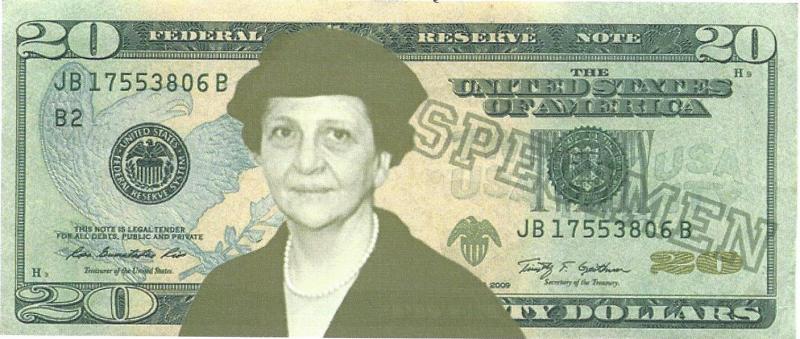On a chilly February night in 1933, a middle-aged woman waited expectantly to meet with her employer at his residence on the East 65th Street in New York City. She clutched a scrap of paper with hastily written notes.
He wanted her to take an assignment, but she had decided she wouldn’t accept it unless he allowed her to do it her own way. She held up the piece of paper in her hand.
She showed him the items: a 40-hour workweek, a minimum wage, worker’s compensation, unemployment compensation, a federal law banning child labor, direct federal aid for unemployment relief, Social Security, a revitalized public employment service, and health insurance.
She braced for his response. “Nothing like this has ever been done in the United States before,” she said. “You know that don’t you?” He said he get would back her. –Kirstin Downey, The Woman Behind the New Deal.
She was Frances Perkins, and the above account is the true exchange between Perkins and President Elect Franklin Delano Roosevelt prior to her accepting the position as his Secretary of Labor. She went on to see all but one of these demands implemented in her 12 years in his cabinet, national health insurance. Frances Perkins was also the first woman to serve in a President’s Cabinet.
Last summer, President Barack Obama mentioned during an appearance in Kansas City, Missouri that he thought that putting a woman on a U.S. currency note was a “pretty good idea.” This observation came after mentioning that a girl had written to him about the idea.
Since then, an organization, “Women on 20s,” has been formed and begun an online polling process at its website, www.womenon20s.org Visitors to the website are asked to choose three women among the 15 whose lives and contributions are summarized. Later, a second balloting will rank the top three.
Among the 15 is Frances Perkins. While there are many American women who deserve more recognition than history has granted so far, Frances Perkins is the woman who ought to be the next person to grace the $20 bill, replacing Andrew Jackson. Thanks to Frances Perkins, we now have Social Security, national unemployment insurance, workers’ compensation, child labor laws and the minimum wage. It was for those accomplishments that newscaster Lawrence O’Donnell last year recommended Perkins for the currency honor.
Frances Perkins graduated from Mt. Holyoke College in 1902 as the president of her class and became a social worker in Chicago, Philadelphia, and New York. In New York she earned a Master’s Degree in Political Science at Columbia University in 1910 and was sufficiently prominent in her work for the people of New York that former President Theodore Roosevelt recommended her for a role on the commission investigating the Triangle Shirtwaist fire of 1911. Because of her work over three years on the Factory Investigating Commission, it was later said that the New Deal began on the day of that tragic fire which she witnessed and during which 146 workers died. All this was before women could vote.
As a member and then as chair of the New York Industrial Commission under both Governors Al Smith and Franklin Roosevelt, she helped implement many of the laws that were the result of the Factory Investigating Commission dealing with work place safety and working conditions for labor. When President-Elect Roosevelt asked Frances Perkins to be his Secretary of Labor, she gave him her list of policy priorities. When FDR pledged to support these reforms, Perkins agreed to serve as Secretary of Labor, a position she held through all twelve years of Roosevelt’s presidency. These initiatives in New York State under both Smith and Roosevelt as governors became the core of the New Deal as the Great Depression deepened.
Frances Perkins was a self-made woman from Newcastle, Maine who defied the contemporary stereotypes of the proper roles for women. When her husband became mentally ill, she assumed the role of breadwinner for her family which included her daughter, and continued to support her husband and his care until his death in 1952. Shortly thereafter, she resigned from her position as a Civil Service Commissioner, to which she was appointed by President Truman.
As social worker and almost-single parent, Frances Perkins knew the value of money for herself and millions of Americans who were desperately poor due to conditions beyond their control from old age, workplace accidents and unemployment. In the 1930s a $20 bill was a good weekly wage for those workers fortunate enough to have jobs.
After her government service, she continued to work until the day she died in 1965 at the age of 85. At that time, she was a visiting professor at Cornell University’s School of Industrial and Labor relations and lived on campus at Telluride House, a student residence.
To support the memory of Frances Perkins, the Frances Perkins Center was formed in 2009. The Center recommended in 2014 to Treasury Secretary Lew that Frances Perkins be honored with a place on a U.S. currency bill. In 1965, President Lyndon Johnson called Frances Perkins to thank her, after the House of Representatives had passed what later became the Medicare amendments to the Social Security program. Given her recommendation in 1933 to President-elect Roosevelt that the country implement national health insurance, it would be appropriate that this administration, the sponsor of the Affordable Care Act, put Frances Perkins on the $20 bill.
































.png)
.png)

